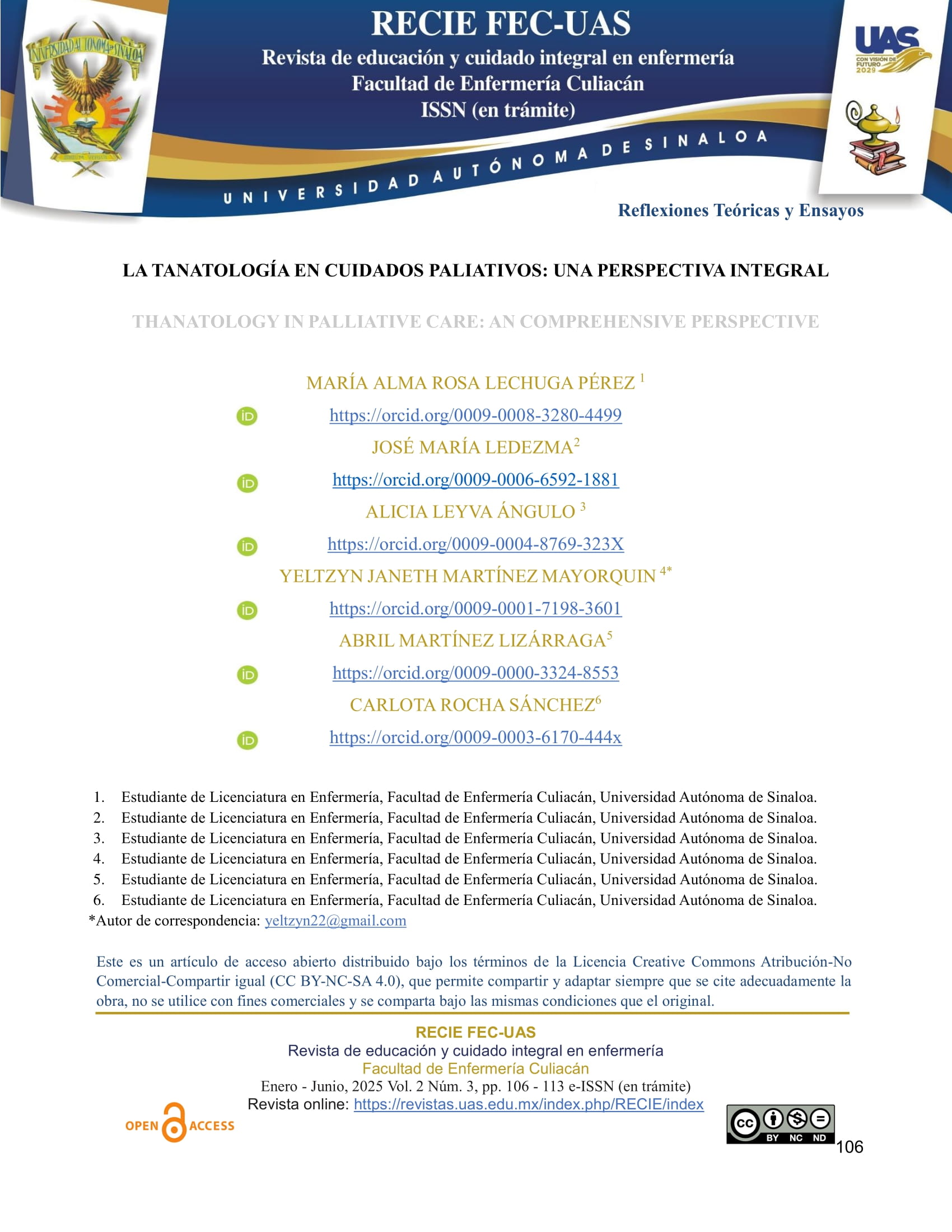Thanatology in palliative care: an comprehensive perspective
Keywords:
Thanatology; Palliative; Psychological; Nursing team., Thanatology, Palliative, Psychological, Nursing teamAbstract
Introduction: Patients with terminal illnesses are increasing over the years. It is important to have healthcare professionals to provide comprehensive care, as terminally ill patients need integrated care that addresses emotional, psychological, physical, and psychosocial aspects. Objective: To understand the importance of thanatology in patients receiving palliative care. Development: Palliative care offers comprehensive intervention for patients with terminal illnesses or conditions that affect their quality of life. This care should be inclusive, covering patients, caregivers, and families. Various studies have investigated the impact of pain on the quality of life of oncology patients, highlighting the importance of pharmacological treatment. Palliative care helps manage the suffering of patients with terminal diagnoses and ensures a dignified death through multidisciplinary care. These strategies aim to improve the quality of life for patients of all ages, focusing on preventing and alleviating pain and other physical, psychological, social, or spiritual ailments. Conclusion: Affective communication in palliative care cases is crucial among patients, families, and the healthcare team. It involves not only the transmission of information but also active listening, as well as the commitment to understand and share the needs and emotions of the patient. Terminal patients are the most vulnerable among our patients.
Downloads
References
Asociación Mexicana de Tanatología [AMT], (2022). ¿Qué es tanatología? Asociación Mexicana de Tanatología. https://tanatologia.org.mx/que-es-tanatologia/
Cano Aguilera, A., Casado López, N., & Chinchilla Azorín, A. (2024). Cuidados paliativos de enfermería en un paciente terminal oncológico. Ocronos - Editorial Científico-Técnica. DOI: https://doi.org/10.58842/JDNE5366
De la Rica E., M., García B, A., & Monche P, A. M. (2019). Valoración de la necesidad de atención paliativa de pacientes crónicos avanzados en el momento del alta hospitalaria. Enfermería Clínica, 29(1), 18-26. DOI: https://doi.org/10.1016/j.enfcli.2018.07.004
Freitas, T. L. L., Banazeski, A. C., Eisele, A., de Souza, E. N., Bitencourt, J. V. de O. V., & Souza, S. S. de. (2016). La visión de la Enfermería ante el Proceso de Muerte y Morir del paciente crítico: una revisión integradora. Enfermería global, 15(41), 322-334. http://scielo.isciii.es/scielo.php?script=sci_arttext&pid=S1695- 61412016000100015&lng=es&tlng=es
Justino, E. T., Kasper, M., Santos, K. D. S., Quaglio, R. C., & Fortuna, C. M. (2020). Cuidados paliativos en la atención primaria de salud: revisión exploratoria. Revista Latino-Americana de Enfermagem, 28. DOI: https://doi.org/10.1590/1518-8345.3858.3324
Pérez, M.B. (2023). Intervención tanatología en cuidados paliativos, revista académica sociedad del conocimiento Cunzac, 3(2),18. https://www.researchgate.net/publication/373988530_Intervencion_tanatolo gica_en_cuidados_paliativos
Radbruch, L. (2020). Definición consensuada de cuidados paliativos. Asociación Internacional de Hospicios y Cuidados Paliativos. https://cuidadospaliativos.org/definicion-consensuada-de-cuidados-paliativos/
Souza, M. C. dos S., Jaramillo, R. G., & Borges, M. da S. (2021). Confort de los pacientes en cuidados paliativos: una revisión integradora. Enfermería Global, 20(1), 420-465.https://scielo.isciii.es/scielo.php?script=sci_arttext&pid=S1695-61412021000100017
Vázquez-García, D., De-la-Rica-Escuín, M., Germán-Bes, C., & Caballero-Navarro, A. L. (2023). Ansiedad y miedo a la muerte en profesionales de la salud en servicios de urgencias hospitalarias en Aragón. Enfermería Clínica (Edición en inglés), 33(4), 269-277. DOI: https://doi.org/10.1016/j.enfcle.2023.03.003

Downloads
Published
Issue
Section
Categories
License
Copyright (c) 2025 RECIE FEC-UAS Revista de educación y cuidado integral en enfermería Facultad Enfermería Culiacán

This work is licensed under a Creative Commons Attribution-NoDerivatives 4.0 International License.

